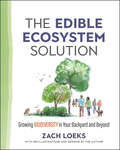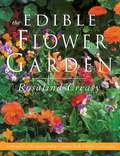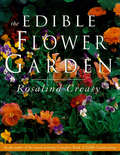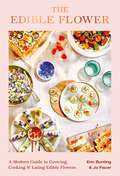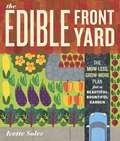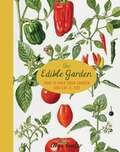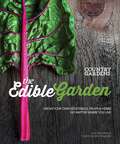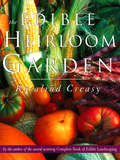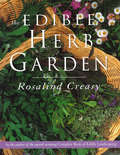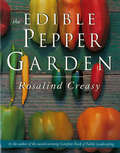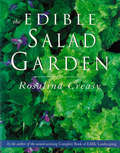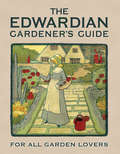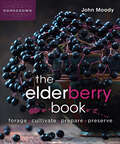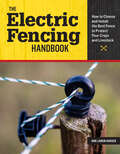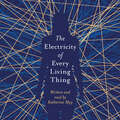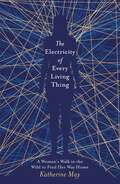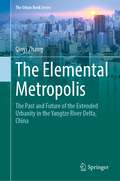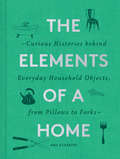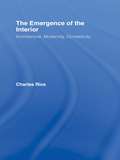- Table View
- List View
The Edible Ecosystem Solution: Growing Biodiversity in Your Backyard and Beyond
by Zach LoeksStart a peaceful revolution by planting an edible ecosystem and sharing the experience with your neighborsHumans have always thrived in rich, diverse, edible ecosystems. Yet most cities and suburbs are blanketed by lawns, ornamentals, and a lack of biodiversity, let alone anything edible. It is within these sterile landscapes that seeds of an edible ecosystem lie.The Edible Ecosystem Solution is a comprehensive, practical guidebook that looks at underutilized spaces to reveal the many opportunities for landscape transformation that are both far-reaching and immediately beneficial and enjoyable. Contents include:Hundreds of full-color infographics, illustrations, and photographs that clearly outline the principles and concepts of edible landscape design and benefitsHow to get started with as little as 25 square feet of landHow to transition a garden plot into a place of edible abundance and an edible biodiversity hot spot, living laboratory, and a source point for transitioning and transforming community and cultureChoosing appropriate plants for insects, wildlife, and food productionScaling up and networking backyard edible ecosystems at the neighborhood level and beyond to build community food security and resilience.The Edible Ecosystem Solution is for everyone with access to a bit of yard, a desire for food security, biodiversity, and a beautiful and resilient community, and for anyone who wants to reclaim humanity's place in a rich, abundant, edible ecosystem.
The Edible Flower Garden
by Rosalind CreasyA comprehensive guide to selecting and growing flowers that can be used for cookery, both as garnishes and as ingredients.
The Edible Flower Garden
by Rosalind CreasyThe Edible Flower Garden is a beautiful collection of flowers that can be used for cookery: from candied violets and roses to decorate appetizers and cakes, to nasturtiums for a colorful shrimp salad, to day lily buds, pink clover, and wild mustard flowers that are tossed together in a spectacular stir-fry.
The Edible Flower Garden
by Rosalind CreasyThe Edible Flower Garden is a beautiful collection of flowers that can be used for cookery: from candied violets and roses to decorate appetizers and cakes, to nasturtiums for a colorful shrimp salad, to day lily buds, pink clover, and wild mustard flowers that are tossed together in a spectacular stir-fry.
The Edible Flower Garden
by Rosalind CreasyLearn how to grow lovely and fragrant flowers then use them create delicious meals with this beautifully illustrated flower gardening and cooking book.Anyone who picks up The Edible Flower Garden will be tempted to grow, harvest, and sample at least a few of the more than forty varieties of edible flowers. Among them you'll find more familiar food plants--dill and mustard, for example--in addition to common flowers, such as tulips or roses. Author Rosalind Creasy's stunning photography and detailed plans for an edible flower garden make this a must-gave book for any flower gardener or home chef.Come along with Creasy on a tour in colorful pictures and careful diagrams and descriptions of her own flower gardens. Included is a tour of the edible flower gardens of Alice Waters famed Chez Panisse restaurant.Creasy catalogues each variety of flower and how to grow it, plus gives a myriad of delectable ideas on how to use the flower from candied violets and roses to decorate appetizers and cakes, to nasturtiums for a colorful shrimp salad, to day lily buds, pink clover and wild mustard flowers that are tossed together in a spectacular stir-fry.
The Edible Flower: A Modern Guide to Growing, Cooking and Eating Edible Flowers
by Jo Facer Erin BuntingOn a seven-acre small holding in rural Northern Ireland, organic gardener Jo Facer and head chef Erin Bunting run fork-to-fork supper club, organic small-holding and fledgling cooking and growing school, The Edible Flower. In their first cookbook, learn to grow and cook edible flowers with Jo and Erin's delicious recipes inspired by the seasonal produce they grow in their kitchen garden and the wild food they forage from their local shores and hedgerows. Feast, celebrate and bring people together with over 50 recipes for small plates, mains, desserts, baking, snacks and drinks, at once fresh and flavourful and absolutely stunning to serve. Recipes include: Ribboned Courgette & Avocado Salad with Poppy Seeds & Calendula, Pot Marigold Soda Bread,Lilac Panna Cotta with Strawberries,Rice with Lemon Verbena, Cardamom & Edible Flower Petals,Marigold Petal Pasta,Courgette Flower Tacos,Carnation and Blackberry Cooler,Slow Roast Lamb with Lavender, Lemon & Apricots, Blackberry & Sweet Geranium Tart,Vietnamese Summer Rolls with Violas,Aubergine Katsu Curry with Pickled Magnoliaand many more ...
The Edible Front Yard: The Mow-Less, Grow-More Plan for a Beautiful, Bountiful Garden
by Ivette Soler“Front lawns, beware: The Germinatrix has you in her crosshairs! Ivette Soler is a welcome voice urging us to mow less and grow some food—in her uniquely fun, infectious yet informative way.” —Garden RantPeople everywhere are turning patches of soil into bountiful vegetable gardens, and each spring a new crop of beginners pick up trowels and plant seeds for the first time. They're planting tomatoes in raised beds, runner beans in small plots, and strawberries in containers. But there is one place that has, until now, been woefully neglected—the front yard. And there's good reason. The typical veggie garden, with its raised beds and plots, is not the most attractive type of garden, and favorite edible plants like tomatoes and cucumbers have a tendency to look a scraggily, even in their prime. But The Edible Front Yard isn't about the typical veggie garden, and author Ivette Soler is passionate about putting edibles up front and creating edible gardens with curb appeal. Soler offers step-by-step instructions for converting all or part of a lawn into an edible paradise; specific guidelines for selecting and planting the most attractive edible plants; and design advice and plans for the best placement and for combining edibles with ornamentals in pleasing ways. Inspiring and accessible, The Edible Front Yard is a one-stop resource for a front-and-center edible garden that is both beautiful and bountiful year-round.
The Edible Garden
by Alys FowlerIn this timely new book, BBC star and Gardening World's thrifty and resourceful Alys Fowler shows that there is a way to take the good life and re-fashion it to fit in with life in the city. Abandoning the limitations of traditional gardening methods, she has created a beautifully productive garden where tomatoes sit happily next to roses, carrots are woven between the lavenders and potatoes grow in pots on the patio. And all of this is produced in a way that mimics natural systems, producing delicious homegrown food for her table. And she shares her favorite recipes for the hearty dishes, pickles and jams she makes to use up her bountiful harvest, proving that no-one need go hungry on her grow-your-own regime.Good for the pocket, good for the environment and hugely rewarding for the soul, The Edible Garden urges urbanites everywhere to chuck out the old gardening rules and create their own haven that's as good to look at as it is to eat.
The Edible Garden: Grow Your Own Vegetables, Fruits & Herbs No Matter Where You Live
by The Editors of Country Gardens MagazineA seasonal guide to crops with descriptions of varieties for each, including when and how to plant. All the basics you need to start, from tools and containers to seeds and soil. Simple recipes that show how to use your crop yield—and what to do when your garden produces more than you ever expected! Covers a wide range of topics, including: Starting from Seed: Save money by growing from seeds—including those you save yourself from your everyday meals. Making the Plan: How to assess the space at hand and plan to use it most efficiently, including seasonal tips for various environments. Organic Solutions: Raise the healthiest food and protect the environment with these handy hints, including all-natural, chemical-free pest repellants, weed control, and soil enrichment. Container Gardening: Grow food for your table on a balcony, patio, or other small space. Special tips on how to grow some basics even if you&’ve only got a window box to work with. Raised-Bed Gardens: All the rage in suburban front and back yards, rooftops, and community gardens, this results-intensive gardening method yields amazing harvests. Yard-to-Table: Recipes for your backyard bounty focusing on just-picked delights such as fresh tomato and arugula salad, crispy zucchini fritter, and cool cucumber sangria.
The Edible Garden: How to Have Your Garden and Eat It, Too
by Alys FowlerIn this timely new book, BBC star and Gardening World's thrifty and resourceful Alys Fowler shows that there is a way to take the good life and re-fashion it to fit in with life in the city. Abandoning the limitations of traditional gardening methods, she has created a beautifully productive garden where tomatoes sit happily next to roses, carrots are woven between the lavenders and potatoes grow in pots on the patio. And all of this is produced in a way that mimics natural systems, producing delicious homegrown food for her table. And she shares her favorite recipes for the hearty dishes, pickles and jams she makes to use up her bountiful harvest, proving that no-one need go hungry on her grow-your-own regime. Good for the pocket, good for the environment and hugely rewarding for the soul, The Edible Garden urges urbanites everywhere to chuck out the old gardening rules and create their own haven that's as good to look at as it is to eat.
The Edible Heirloom Garden
by Rosalind CreasyRosalind Creasy invites gardeners into the colorful and diverse world of heirloom vegetables. Plant, grow, and harvest the vegetables of a century ago, and serve them up using some of the delightful traditional recipes (with modern twists) in this sumptuous book.Replete with photographs of tomatoes, squash, carrots, beans, cabbages and many more, reminiscent of an old-time county fair, Creasy takes you on a tour of heirloom gardens from New England to Idaho and back to the Iowa heartland, where, Kent Whealy points out, many heirloom vegetables are native. In "How To Grow an Heirloom Garden," Creasy gives extensive instructions on saving and storing seeds from year to year. The "Resources" section of the book lists numerous sources for heirloom seeds.The "Encyclopedia of Heirloom Vegetables" section offers beets in white, deep red, and purple, as well as potatoes and tomatoes of every hue and shape. No list of heirloom vegetables would be complete without a section on parsnips, rutabaga, and turnips-the root vegetables that got our forebears through many a long winter.Creasy provides recipes for every season, including "Roasted Parsnips," which can be made fresh from the garden even in winter. Begin a meal with hearty "Beerocks" and end with mouth-watering "Carrot Pie," which, as Creasy points out, wouldn't have been considered dessert at all in Colonial days.
The Edible Herb Garden
by Rosalind CreasyNow from the doyenne of edible landscaping comes a comprehensive and accessible guide to cultivating and cooking herbs.If you have only one book on growing, harvesting and cooking with herbs, this should be it. Creasy takes you from seeds to stove top, from preparing soil to elegant dining, with easy-to-follow instructions and inspirational, imaginative ideas for every step of the way, with a complete "Resources" section.There's information on how to design and grow an herb garden just about anywhere - from a spacious country plot to a small city balcony, from California to Maine and anywhere in between.
The Edible Herb Garden
by Rosalind CreasyNow from the doyenne of edible landscaping comes a comprehensive and accessible guide to cultivating and cooking herbs.If you have only one book on growing, harvesting and cooking with herbs, this should be it. Creasy takes you from seeds to stove top, from preparing soil to elegant dining, with easy-to-follow instructions and inspirational, imaginative ideas for every step of the way, with a complete "Resources" section.There's information on how to design and grow an herb garden just about anywhere - from a spacious country plot to a small city balcony, from California to Maine and anywhere in between.
The Edible Herb Garden
by Rosalind CreasyLearn how to grow hardy and fragrant herbs then use them create delicious meals with this beautifully illustrated herb gardening and cooking book. Author Rosalind Creasy takes you from seeds to stove top, from preparing soil to elegant dining, with easy-to-follow instructions and inspirational, imaginative ideas for every step of the way, with a complete "Resources" section. There's information on how to design and grow an herb garden just about anywhere--from a spacious country plot to a small city balcony, from California to Maine and anywhere in between. With vivid photographs you'll tour various gardens Creasy has created, plus the garden of herb luminary Carole Saville, among others.The comprehensive, fully illustrated "Encyclopedia of Culinary Herbs" section illustrates how to grow and use more than two dozen herb varieties. It includes both old favorites--basil, rosemary, sage, and the like--as well as more exotic herbs from around the world, including salad burnet, lemon verbena, and Mexican tarragon.In the "Favorite Herb Recipes" section you'll find delicious recipes as well as instructions for accompaniments--herb blends and butters, vinegars and teas; main dishes from cuisines around the world; and even cocktails and desserts
The Edible Mexican Garden
by Rosalind CreasyWith gorgeous, four-color photographs, and simple yet authoritative text, award-winning author Rosalind Creasy offers four new volumes in her popular Edible Garden series, each featuring helpful hints, expert gardening techniques, delicious recipes, and interviews with master gardeners and renowned chefs. The most unassuming of garden vegetables from your garden- corn, beans, peppers, greens, and onions- are transformed into traditional and contemporary Mexican dishes and delicacies to awaken the palate and entice the eye.
The Edible Pepper Garden
by Rosalind CreasyThe Edible Pepper Garden acquaints the pepper novice with the numerous members of the Capsicum annum species-from the pea-sized, blazing-hot chiltepin to the eight-inch sweet banana pepper-and gives the chile initiate inspiration and suggestions to expand their pepper repertoire. With stunning photography and extensive definitions and explanations, Rosalind Creasy, the doyenne of edible landscaping, has taken the American fascination with peppers and made it accessible to the home gardener and home chef alike. Creasy takes us on a tour of two of her own extremely successful pepper gardens-the first yielded twenty-one varieties of hot and sweet peppers! She provides variety-specific growing information along with culinary and preparation suggestions.
The Edible Salad Garden
by Rosalind CreasyCreasy shows readers how to grow favorite salad greens and vegetables then prepare them using delicious and unique recipes. Over 90 color illustrations.
The Edwardian Gardener's Guide
by Twigs WayIt is Edwardian England, and a delightful flower garden and fruitful allotment are matters of personal pride, boons for the dinner table, and even 'important acts of local patriotism'. The Edwardian Gardener's Guide selects nuggets of wisdom from the best-selling One & All garden books, originally published in 1913. In these short booklets, the foremost agricultural and horticultural writers of the period revealed fashions in gardening styles, the best seasonal plants, how to enhance food production and now best to lay out adventurous rockeries, ferneries and grottoes. Packed with charming contemporary advertisements and color illustrations, this handbook gives a glimpse of the pre-First World War 'golden era' of British gardening. With an introduction by garden historian, Twigs Way.
The Elderberry Book: Forage, Cultivate, Prepare, Preserve (Homegrown City Life)
by John MoodyYour go-to guide for everything from cultivation to wine-making with one of humanity's oldest plant friendsSpanning history and geography, The Elderberry Book takes you on an adventure, deepening your appreciation of a plant that has played a crucial role across the world for thousands of years. Through this fun, inspirational, and educational resource, discover:Elderberry's amazing historyCultivating and foraging, from the balcony to the backyardVarious traditional food and medicine preparationsSimple wine-making techniquesTraditional crafts and tools.This is the definitive guide to the many uses of elderberry. No matter where you are, one of humankind's oldest plant friends can provide you with anything from syrup, to wine, to dyes, to so much more!Once a staple in homes across the world, and found along every highland, highway, and hedgerow, the forgotten elderberry is making a comeback. Its popularity as medicine is surging, its choice as an edible landscaping plant is growing, and its use for wine-making and crafts is being rediscovered.
The Electric Fencing Handbook: How to Choose and Install the Best Fence to Protect Your Crops and Livestock
by Ann Larkin HansenUse electric fencing to protect your livestock, poultry, beehives, and garden. Portable electric fencing is key to successful rotational grazing, while permanent electric fencing effectively protects gardens and orchards and secures large pastures. Through clear instructions accessible to everyone, you’ll learn when to use these methods or a combination of the two, plus how to plan for, build, and maintain your electric fencing. This crucial tool is cost effective and versatile, but veteran farmer and author Ann Larkin Hansen also explains what not to do with an electric fence.
The Electricity of Every Living Thing: A Woman's Walk in the Wild to Find Her Way Home
by Katherine MayLast summer, Katherine May was approaching 40, feeling overwhelmed by motherhood and lacking connection with others, lost in a world of inundation and expectation. She had always felt different but this feeling was new. She wanted to get out, get free and find herself again - and so set about walking the rugged 450 mile South West Coast Path. However, this journey uncovers more than she ever imagined. By chance, en route to the walk, Katherine hears a radio show and the guests are speaking about Asperger's Syndrome. Things begin to fall into place - could this explain the white-outs, the excruciating confusion around social contact, the electric feeling of every living thing?After a formal diagnosis, Katherine begins to unravel this new perspective of her life. Through her physical journey comes an emotional one - of accepting who she is and moving forward. It's not just about walking or Asperger's; this is one woman's journey to feel free within herself, something that everyone can relate to.Read by Nathalie Buscombe(p) Orion Publishing Group 2018
The Electricity of Every Living Thing: From the bestselling author of Wintering
by Katherine MayFrom the bestselling author of Wintering, Katherine May, The Electricity of Every Living Thing is a life-affirming and poignant exploration of nature, and how reconnecting to wild landscapes can create peace in our unquiet minds.'A windswept tale, beautifully told' Raynor Winn, author of The Salt Path 'A manifesto for the value of difficult people. I loved it' Amy Liptrot, author of The OutrunIn August 2015, Katherine May set out to walk the 630-mile South West Coast Path. She wanted to understand why she had stopped coping with everyday life; why motherhood had been so overwhelming and isolating, and why the world felt full of inundation and expectations she can't meet. Setting her feet down on the rugged and difficult path by the sea, the answer begins to unfold.The Electricity of Every Living Thing tells the story of the year in which Katherine comes to terms with a diagnosis which shakes her to her core. It leads to a re-evaluation of her life so far - a kinder one, which finally allows her to be different rather than simply awkward, arrogant or unfeeling. The physical and psychological journeys become inextricably entwined, and as Katherine finds her way across the untameable coast, she also finds the way to herself.What readers are saying about The Electricity of Every Living Thing:'Honest and sensitive' 'The astonishing sensitivity and awareness in her writing, both about the beautiful landscapes and nature around on her walks, and in relation to her family, friends and self put paid to many outdated myths about what it is like to be autistic''Compelling and transformative. I could not put this book down so I stayed in bed and read it in one go.''Katherine has a fantastic way with words, I could read her books for hours on end, they are calming and relatable.''Read it - you won't regret it.'
The Elemental Metropolis: The Past and Future of the Extended Urbanity in the Yangtze River Delta, China (The Urban Book Series)
by Qinyi ZhangThis book provides a multi-scale reading of the spatial “elements” in which the extensive urbanity in Yangtze River Delta is constructed, and from there an imagination of a new paradigm of urbanization. The urbanization in Yangtze River Delta today is in need of a new interpretation and paradigm. The delta is a territory with city cores but it also has vast dispersed urbanization where the agricultural and non-agricultural activities and spaces are mixed and interlinked, a desakota (McGee, 1991). This book attempts to answer a basic question: what is the desakota in the Yangtze River Delta made of? The research Horizontal Metropolis led by Prof. Paola Viganò at EPFL, Switzerland focuses on the form of the contemporary city – the fragmentary spatial condition and dispersed urbanity all over the world. The study on Yangtze River delta is part of its research frame.
The Elements of a Home: Curious Histories behind Everyday Household Objects, from Pillows to Forks
by Amy AzzaritoThe Elements of a Home reveals the fascinating stories behind more than 60 everyday household objects and furnishings. Brimming with amusing anecdotes and absorbing trivia, this captivating collection is a treasure trove of curiosities.With tales from the kitchen, the bedroom, and every room in between, these pages expose how napkins got their start as lumps of dough in ancient Greece, why forks were once seen as immoral tools of the devil, and how Plato devised one of the earliest alarm clocks using rocks and water—plus so much more.• A charming gift for anyone who loves history, design, or décor• Readers discover tales from every nook and cranny of a home. • Entries feature historical details from locations all over the world, including Europe, Asia, North America, and Africa. As a design historian and former managing editor of Design*Sponge, author Amy Azzarito has crafted an engaging, whimsical history of the household objects you've never thought twice about. The result is a fascinating book filled with tidbits from a wide range of cultures and places about the history of domestic luxury.• Filled with lovely illustrations by Alice Pattullo• Perfect as a housewarming or wedding gift, or for anyone who adores interior design, trivia, history, and unique facts• Great for those who enjoyed The Greatest Stories Never Told: 100 Tales from History to Astonish, Bewilder, and Stupefy by Rick Beyer, An Uncommon History of Common Things by Bethanne Patrick and John Thompson, Encyclopedia of the Exquisite: An Anecdotal History of Elegant Delights by Jessica Kerwin Jenkins
The Emergence of the Interior: Architecture, Modernity, Domesticity
by Charles RiceTaking a radical position counter to many previous histories and theories of the interior, domesticity and the home, The Emergence of the Interior considers how the concept and experience of the domestic interior have been formed from the beginning of the nineteenth century. It considers the interior's emergence in relation to the thinking of Walter Benjamin and Sigmund Freud, and, through case studies, in architecture's trajectories toward modernism. The book argues that the interior emerged with a sense of 'doubleness', being understood and experienced as both a spatial and an image-based condition. Incorporating perspectives from architecture, critical history and theory, and psychoanalysis, The Emergence of the Interior will be of interest to academics and students of the history and theory of architecture and design, social history, and cultural studies.
